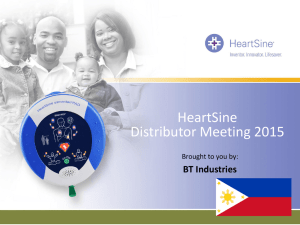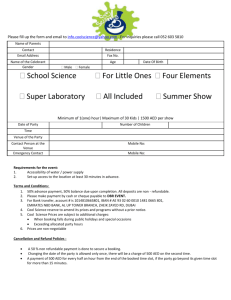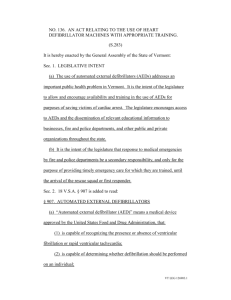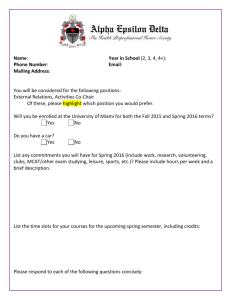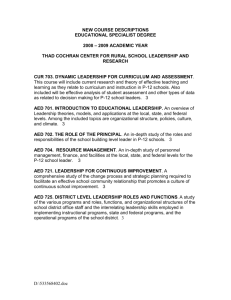The following is a guide to the key features to look for when
advertisement
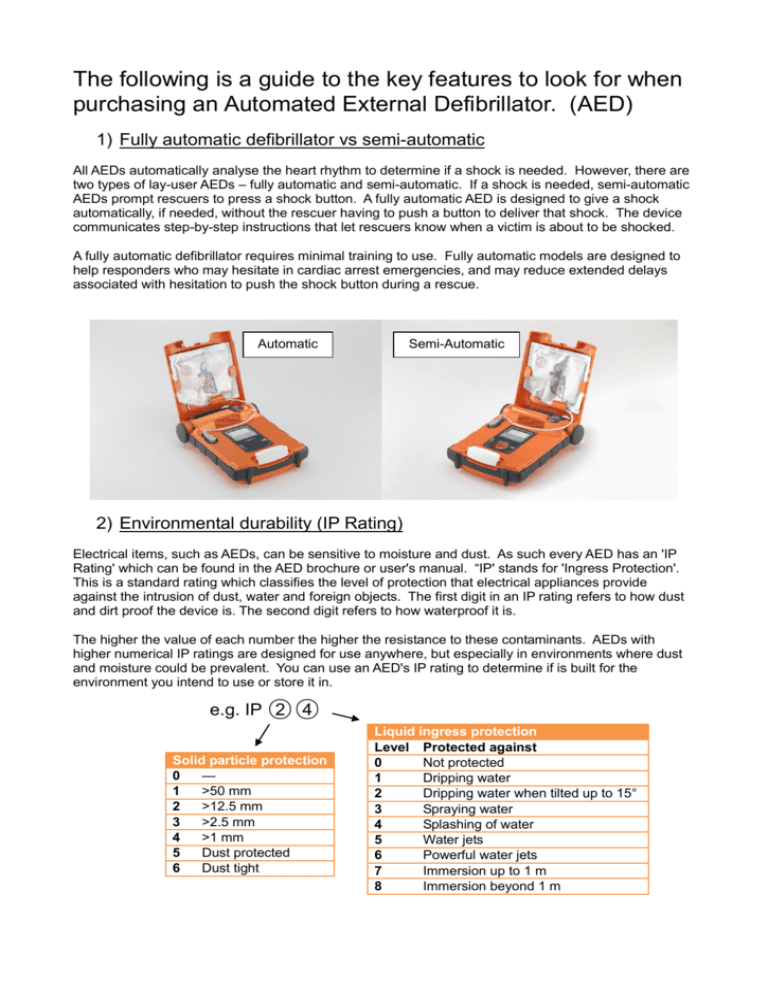
The following is a guide to the key features to look for when purchasing an Automated External Defibrillator. (AED) 1) Fully automatic defibrillator vs semi-automatic All AEDs automatically analyse the heart rhythm to determine if a shock is needed. However, there are two types of lay-user AEDs – fully automatic and semi-automatic. If a shock is needed, semi-automatic AEDs prompt rescuers to press a shock button. A fully automatic AED is designed to give a shock automatically, if needed, without the rescuer having to push a button to deliver that shock. The device communicates step-by-step instructions that let rescuers know when a victim is about to be shocked. A fully automatic defibrillator requires minimal training to use. Fully automatic models are designed to help responders who may hesitate in cardiac arrest emergencies, and may reduce extended delays associated with hesitation to push the shock button during a rescue. Automatic Semi-Automatic 2) Environmental durability (IP Rating) Electrical items, such as AEDs, can be sensitive to moisture and dust. As such every AED has an 'IP Rating' which can be found in the AED brochure or user's manual. “IP' stands for 'Ingress Protection'. This is a standard rating which classifies the level of protection that electrical appliances provide against the intrusion of dust, water and foreign objects. The first digit in an IP rating refers to how dust and dirt proof the device is. The second digit refers to how waterproof it is. The higher the value of each number the higher the resistance to these contaminants. AEDs with higher numerical IP ratings are designed for use anywhere, but especially in environments where dust and moisture could be prevalent. You can use an AED's IP rating to determine if is built for the environment you intend to use or store it in. e.g. IP ○ 2 ○ 4 Solid particle protection 0 — 1 >50 mm 2 >12.5 mm 3 >2.5 mm 4 >1 mm 5 Dust protected 6 Dust tight Liquid ingress protection Level Protected against 0 Not protected 1 Dripping water 2 Dripping water when tilted up to 15° 3 Spraying water 4 Splashing of water 5 Water jets 6 Powerful water jets 7 Immersion up to 1 m 8 Immersion beyond 1 m 3) Energy – Fixed energy vs variable escalating energy Fixed energy AEDs deliver the same level of energy for every shock, regardless of the individual. The amount of energy delivered varies with each manufacturer and ranges from 150 joules to 360 joules. Some AEDs also escalate if the first shock is unsuccessful. Other AEDs incorporate variable escalating energy. This technology identifies the patient's level of energy impedance, resulting from muscle tissue, fat tissue and water retention. The AED then delivers a customized shock based on the level of energy impedance. The level of energy then escalates for subsequent shocks. This variable escalating energy ensures that even hard-to-defibrillate patients receive the best chance for a successful outcome, while minimizing the damage to tissue that can result from excess energy. Will these two people require the same level of energy for successful defibrillation? 4) Battery life To save valuable time and as they may be needed in an area where there is no electrical outlet, AEDs are powered by batteries. It can be said that AED batteries are one of the most important components of an AED unit. Without a battery, the AED will not work. An important part of any AED program is ensuring that your AED battery is charged and in working order. It can be a matter of life and death. One quarter of AED failures can be linked to battery failure. The longer the battery life, the easier an AED is to maintain and the more confident an owner will be. Batteries can be single use and so need to be replaced after use. Other batteries are replaced on a regular cycle, regardless of use. This cycle can be as long as four years. Battery solutions range from consumer batteries purchased by the owner, a charge stick that charges the internal battery, a battery pack containing CR123 batteries, or a medical grade lithium battery. Medical grade Battery Pack CR123 Battery Pack 5) Self-testing Most AEDs are able to test their own circuitry, software and batteries regularly. A smaller number also check for the presence and function of the pads. These AEDs will alert an owner if there is a problem. Self-testing is one of the most important aspects of determining the reliability of an AED. Typically AEDs with higher capacity batteries will provide the most comprehensive self-testing. Rescue Ready Indicator 6) AED guidance / voice prompts a) User paced prompts All AEDs feature visual and/or voice prompts. These prompts instruct the rescuer on exactly what to do from the moment they open the lid of the AED, including where to place the pads and how to perform CPR. Some AEDs also include a metronome counting out the correct rate of compressions to breaths. b) CPR feedback Several AEDs now feature CPR feedback to help the rescuer achieve the correct rate and depth of chest compressions. Recent studies show that correct compression rate and depth improve the chances of survival. AEDs that include a CPR feedback device provide instructions to a rescuer so that they perform CPR in accordance with resuscitation council guidelines. CPR Feedback Device 7) Paediatric capability Most AEDs offer paediatric capability. This may involve either a key system or paediatric specific pads. The decision to utilise paediatric capacity mostly depends on the ability for rescuers to quickly decide to use this capacity and change mode or pads accordingly. As survival drops by 10% for every minute defibrillation is delayed, many non-professional owners of AEDs choose to keep it simple and use adult pads. Guidelines also state that should paediatric pads be unavailable the AED should still be used with Adult pads. When using adult pads on children, a device with fixed low energy or variable escalating energy will deliver a more appropriate level shock for their size than a device with fixed high energy. 8) AEDs and corrective action The FDA reported that ¾ of AEDs require corrective actions so it is likely that your AED will require some sort of service over its lifetime. AEDs are a medical device covered by Medicines Regulations 1994 which must be registered with Medsafe (New Zealand Medicines and Medical Devices Safety Authority) and the supplier is required to have a process in place to deal with recalls and corrective action. AED suppliers handle corrective action differently. Some will notify you of the actions required where as others will manage the whole process. The most important thing is to ensure that you are never without an AED whilst your product is being serviced. Ensure the supplier is able to provide a loan unit if required. Also consider how long the supplier has supplied AEDs. Consider whether they likely to be able to support the product for its life time and check what manufactures warrantees and guarantees are available.
